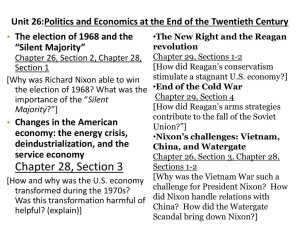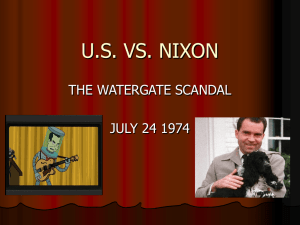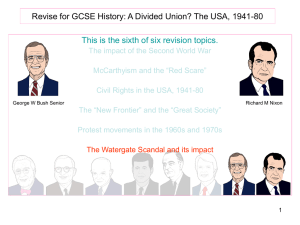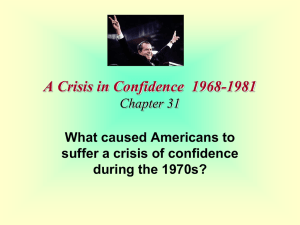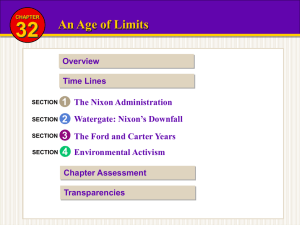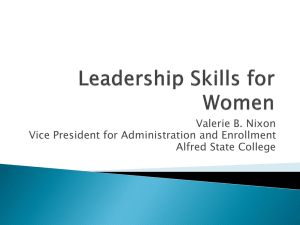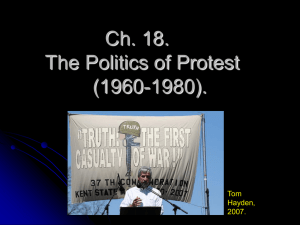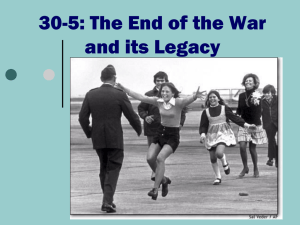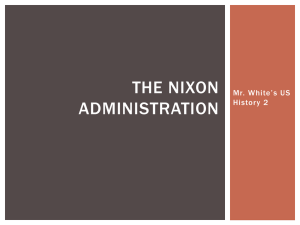Chapter 31 Study Guide
advertisement
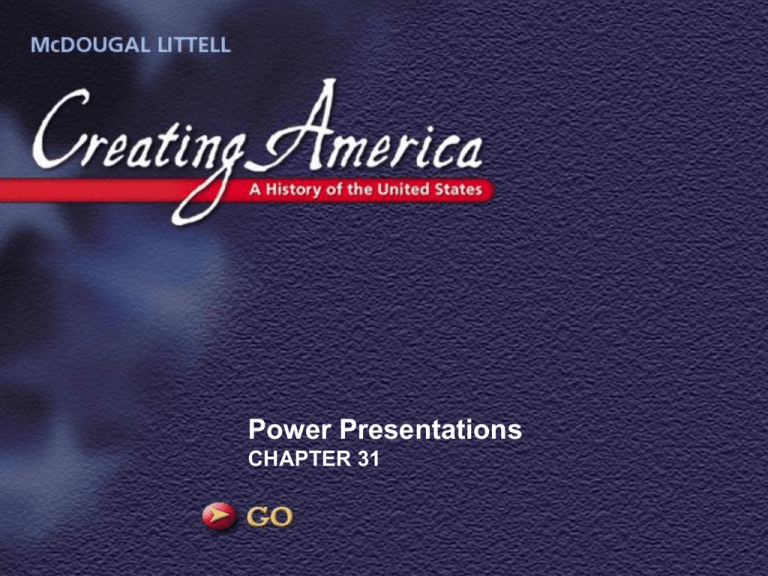
Power Presentations CHAPTER 31 Citizenship Image It is the evening of August 8, 1974. You are watching television when your favorite program is interrupted by a speech from President Richard M. Nixon. Looking grim and tired, Nixon says that he will resign the next day. You wonder how the country will cope with the crisis. How is America able to survive a crisis and move on? • What happens when a president resigns from office? Has a president resigned before? • How has the government functioned when a president has died? • What other crises has the country faced? 1969 Richard M. Nixon is Image inaugurated as president. U.S. astronauts land on moon. 1972 Watergate break-in occurs. Nixon is reelected. 1974 Nixon resigns. Gerald Ford becomes president. 1976 The U.S. celebrates its bicentennial. Jimmy Carter is elected president. 1980 Ronald Reagan is elected president. To World 1969 Golda Meir becomes prime minister of Israel. 1970 Anwar el-Sadat becomes president of Egypt. 1971 General Idi Amin seizes power in Uganda. 1973 U.S. involvement in Vietnam War ends. Military overthrows government of Chile. 1975 South Vietnam surrenders to North Vietnam. 1978 Camp David Accords are signed. 1979 Americans are taken hostage in Iran. Soviet Union invades Afghanistan. 1981 American hostages are released by Iran. Back to U.S. Back to Home Main Idea President Richard M. Nixon faced the challenge of governing a deeply divided America. Why It Matters Now Social, economic, and political divisions are still a part of American life. What problems did President Nixon face during his first term? recession inflation unemployment racial problems PROBLEMS NIXON FACED DURING HIS FIRST TERM crime protests over the Vietnam War Image Cold War tensions • How did Nixon try to show support for law-and-order politics? • What economic problems developed during Nixon’s first term as president? • How did Nixon change the country’s relationship with China? With Russia? Making Inferences Nixon often surprised Americans in the policies that he supported. Which do you think was most surprising? Why? Think About • his economic policies, such as deficit spending • his appointment of conservative justices • the policy of détente Back to Home Main Idea Nixon’s involvement in the Watergate scandal caused a political crisis that forced him to resign. Why It Matters Now Watergate led many Americans to have less confidence in government and politicians. What were the major events of the Watergate scandal? June 1972 Watergate break-in March 1973 John Dean testifies before Senate February 1973 Senate begins investigation July 1973 Taping in White House made public January 1974 House Judiciary Committee begins impeachment hearings July 1974 Judiciary Committee votes to impeach Nixon August 1974 Nixon resigns • Why did Nixon want a big win in the 1972 election? • What kinds of illegal activities was Nixon involved with in the Watergate scandal? • What was the outcome of the Watergate scandal? Forming and Supporting Opinions What do you think would have happened if President Nixon had apologized for Watergate rather than trying to cover it up? Think About • when the break-in occurred • how the nation reacted to past scandals Back to Home Main Idea Presidents Ford and Carter had a difficult time solving the nation’s problems after Watergate. Why It Matters Now These problems helped lead to a conservative mood in the United States. What were the high and low points of the Ford and Carter presidencies? PRESIDENCY HIGHS LOWS Gerald Ford succession to presidency; negotiation of Helsinki Accords pardon of Nixon, failure of WIN program, loss in 1976 Jimmy Carter election as president; negotiation of Panama Canal, Treaties and Camp David Accords clashes with Congress, Iran hostage crisis, loss in 1980 • Why did Carter win the 1976 election over Ford? • What were some problems related to energy use that occurred during Carter’s term? • What progress did the environmental movement make during the 1960s and the 1970s? Comparing How would you compare the strengths and weaknesses of Ford and Carter? Use events from their presidencies to support your answer. Think About • actions each took to draw Americans together • response to economic and foreign policy issues Back to Home REVIEW QUESTIONS ANSWERS: READ AND TAKE NOTES 1 What kinds of government programs did Nixon propose to deal with America’s social problems? 2 How did Nixon try to promote “law and order”? 3 What were the economic problems Nixon faced? 4 How was Nixon’s foreign policy toward China different from that of previous presidents? 5 What were the chief causes of the Watergate scandal? 6 What did reporters and others find when they looked deeply into the Watergate burglary? 7 What were the events that caused Nixon to resign? 8 What were the main reasons people did not vote for Gerald Ford in the 1976 election? 9 What successes did Carter have with foreign policy and what problems did he have at home? 10 What appealed to voters about Ronald Reagan in the 1980 election? Taking Notes PRESIDENT Richard Nixon ISSUES AND EVENTS elected with conservative support; cuts Great Society programs; supports revenue sharing; promises to end social unrest; fights inflation, unemployment, recession, and energy crisis; eases Cold War tension with China and Soviet Union; involved in Watergate scandal; resigns Gerald Ford appointed vice-president; succeeds Nixon as president; pardons Nixon; popularity drops; tries to fight inflation with voluntary WIN program; negotiates Helsinki Accords; defeated by Jimmy Carter Jimmy Carter defeats Ford in 1976 election; promises honesty in government and support for human rights; clashes with Congress; faces energy crisis, inflation, and unemployment; negotiates Panama Canal Treaties and Camp David Accords; supports environmental movement; Iran hostage crisis partly responsible for his defeat in 1980 by Ronald Reagan Back to Home These labels let you know where you are in the presentation. When you click on the arrow you will be linked to a related visual. Map Image These buttons link you to special areas. Use these buttons to go back to the previous slide, or to move forward in the presentation. To reveal the content of a slide just press the space bar or click your mouse once. To use a button, move your pointer over the button. When your pointer becomes a hand, click your mouse. Back to Previous NO MAPS IN CHAPTER 31

